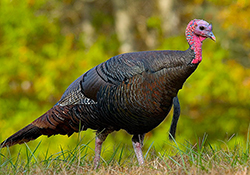By Rabbi Michael Leo Samuel


CHULA VISTA, California — The question of turkey’s status as a permitted (kosher) bird is a topic that comes up every Thanksgiving holiday season. Nevertheless, many Orthodox Jews I personally know will never eat turkey since there is no tradition permitting it.
Clearly, the Torah does not mention turkey at all since it is native to North America. Based on the criteria the Mishnah provides, the turkey does possess all the kosher signs one would expect of a kosher bird. However, the absence of a tradition going back many generations is why some pious observant Jews will not eat turkey. This is in accordance with the Shulchan Aruch that ruled, “no bird should be eaten unless there is a mesorah (tradition) that it is a kosher species.”[1]
The fact the Torah mentions only twenty-four species of birds implies that only those species are considered impure and unfit for consumption, but the majority of birds are considered permitted. It was only in the 16th century the custom arose not to eat any bird that did not have a tradition permitting it. Since Jews had already eaten turkeys prior to that time and therefore the rabbis did not consider it “unkosher.”
Although the Torah did not state the specific tokens regarding fowl, the Sages ruled: “Any fowl which seizes is unclean. Any fowl which has an extra talon [the hallux] and a craw and the skin of the stomach of which [can] be stripped off are clean.” R. Eleazar b. Sadoq says, “Any bird which parts its toes evenly two in front and two in the back is unclean” (Mishnah Hullin 3:6). It is significant that the 4th century Amora named Amemar said, “The law is that every bird that has one characteristic [of cleanness] is clean, that is, if it does not seize prey.” Rashi notes the meaning of Amemar’s opinion is, so long as it does not seize prey and it has, in addition, one characteristic of cleanness, it is clean. However, Tosafot (s.v. tuvu) takes the scholar literally; it does not seize prey is the only characteristic of cleanness that it needs to possess (BT Hullin 62a).
Let me add that it is surprising chicken was never used as a sacrifice in the days of the First or Second Temple. Without giving away the answer, ask your guests: Why was this so?
Back to our topic about turkey. So how did turkey suddenly gain a kosher status?
Inquiring minds really want to know!
Some of the rabbis of the previous centuries identified the turkey as the הוֹדוּ תַּרְנְגוֹל “Indian chicken,” and thought the bird originated in India. Jews were not the only ones who thought this way. The French referred to turkey as poulet d’Inde (“Chicken from India”), as did the Polish, Ukrainian and Russian countries. It was assumed that the rabbis in India permitted it. However, this was an assumption that could never be proven since it was based on a false assumption: Turkeys did not exist in India!
But as erroneous as this view was, subsequent rabbis realized that people had already accepted it as a kosher bird—especially since it had all the kosher characteristics mentioned in the Mishnah.[2] But here is the real reason why turkeys ought to be permitted—from a scientific perspective, it is because turkeys belong to the family of Phasianidae.
From the perspective of taxonomy, the Phasianidae includes a wide variety of birds, including pheasants, partridges, quail, chickens, pea-fowl, wild turkey, and jungle-fowl. The red jungle-fowl (Gallus gallus), is actually the primary progenitor of the domestic chicken. Even if Moses’ time did not specifically know about turkey, they were certainly familiar with quail and chicken. Turkey, pheasants, and peacocks are only a few examples of birds that are part of the Phasianidae genus.
And for those Jews who worry about turkey, it is strange that nobody, not even in rabbinical times, ever wondered as to why chicken was permitted. Chickens did not exist in Mosaic times! But once again, even if the rabbis did not know about the Phasianidae genus, they were most certainly familiar with quail and pheasant. Chickens are kissing cousins of these two birds.
Although pheasant does not appear in the Tanakh, rabbinic tradition [3] identified it with the שְׂלָו (selav) the Israelites had eaten mentioned in Exodus 16:13. The appearance of pheasant and quail are very similar.
The Romans enjoyed eating pheasant. According to one midrashic text, Emperor Hadrian was surprised to discover that pheasants existed in Judea in great supply.[4] The Tosefta mentions pheasants were bred together with peacocks, which is another member of the Phasianidae genus.[5] The Midrash mentions the pheasant as among those rare delicacies, the taste of which the manna could acquire should a person yearn for it.[6]
Historically, the chicken actually makes its first appearance in Israelite art in seals dating back from the late 8th century B.C.E. Poultry and eggs probably did not become common before the 5th-6th-century B.C.E. Some scholars think King Solomon might have served chicken to his royal guests, for the word (barb-rîm = fattened fowl) may be related to the Arabic birbir, meaning young chickens. As a man of means, King Solomon certainly would have been able to import this delicacy.
The earliest drawing of a chicken is that of a rooster on a seal found at Tell en-Nasbeh, some 8 miles north of Jerusalem, which dates back to about 600 B.C.E. The ancient Israelite diet might have consisted of beef, lamb, roebuck, gazelle, wild goat, and deer, quails, turtle doves, pigeons, partridges, geese, (possibly swans) and ducks—but no chickens! In Mosaic times, the chicken was completely unknown. Let us further add, that there is no Hebrew word for chicken, even the name, which later came to describe it, (tarnegol) is really a Sumerian loanword that Biblical Hebrew later adopted during the Persian period. It was at that time, the Jews began to eat chickens and eggs (2 Esd. 1:30).
Here is another piece of kashrut trivia most of you might be surprised to know. In rabbinical times, the Sages ate peacock as a delicacy. The Talmud records an interesting discussion pertaining to R. Yose the Galilean, who ate chicken with milk. On one occasion: Levi visited the house of Joseph the fowler. They served him the head of a peacock cooked in milk. Levi would not eat it. When he came before the Rabbi, he said to him, “How come you didn’t excommunicate them?” He said to him, “It was the locale of R. Judah b. Beterah, and I thought, maybe he expounded for them the rule in accord with the position of R. Yose the Galilean.”[7]
Like the pheasant, chicken, and turkey, the peacock is also a member of the Phasianidae mishpacha!
*
NOTES:
[1] Ari Z. Zivotofsky, “Is Turkey Kosher?” The Journal of Halacha and Contemporary Society, 35( Spring, 1998):79-110.
[3] See the Responsa Meishiv Davar YD:22 by R. Naftali Tzvi Berlin, a.k.a., Netziv.
[3] BT Yoma 75b mentions a tradition associated with R. Hanan b. Abba said: “There are four kinds of slaw [quails]: thrush, partridge, pheasant and quail proper.” Comp. Targum Pseudo-Jonathan on Exodus 16:13. Cf. BT Kiddushin 31a.
[4] Ecclesiastes Rabbah 2:8.
[5] Tosefta Kilayim 1:7. The Tosefta considered the crossbreeding of these birds as violating the laws of Kilayim (forbidden mixtures), despite the fact that these birds belong to the same scientific genus. However, The Talmud mentions a rule known as the “hybridization principle.” This principle states that kosher species cannot mate with non-kosher species; hence, the fact that a suspect species can interbreed with a known kosher species confirms the kosher status of the unknown species (BT Bechorot 7a). This is a question I will address at another time.
[6] Num. Rabbah 7:4. מי שהיה מתאוה תרנגול או פסיון וכ׳ “whoever desired to eat chicken or pheasant, found the taste of it in the manna.”
[7] BT Shabbat 130a.
Posted in Askarabbi, Bible, Responsa Literature, Talmud, Zohar, and Midrash
*
Rabbi Dr. Michael Leo Samuel is spiritual leader of Temple Beth Shalom in Chula Vista. He may be contacted via michael.samuel@sdjewishworld.com
So, is Peacock head served in milk, kosher or not….?
So, the question is… is Peacock head served in milk kosher or not?